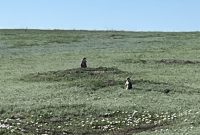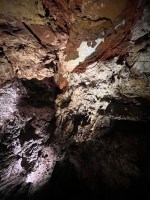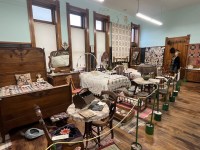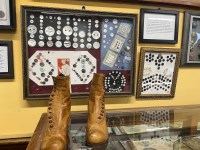Itasca Lake SP to Wind Cave NP 07/02/25 to 07/17/25
As we neared the MN – ND state line, Paula was so pleased the projection of MN having their worst season for mosquitoes in 5 years (4 times worse!) had not affected her and was glad to be leaving MN before any inundation of mosquitoes hatched. After one more night in MN, we crossed into ND headed for our out-of-the-way campsite at Fort Ransom SP to hunker down for the 4th of July weekend. It was the only campsite Tom had been able to find, even a week before the date (and that’s long-term reservation planning for us).

 We were also really surprised to see some activities planned for the weekend. There were two in which we were interested, the first, a ranger-led hike called Finding Colors to search for plants that could be used to make dyes. Despite putting on bug spray, Paula got at least 4 mosquito bites and Tom 3, but he and Whisper both had 2 ticks on their bodies when we did a check after returning to WOW. Then in the afternoon, there was a demonstration titled To Dye For to explore natural dying processes used by settlers and native peoples. Two processes were used – one a water bath (which was very faint-colored), and the second, wrapping a handkerchief around flowers, laying it doubled on cardboard, and hitting it with a rubber hammer, which we both did. Tom chose marigolds, and Paula chose a couple of different purple flowers, then we both sprinkled them lightly with beet juice water. We rode the scooter to both, and Tom managed to go 3 days without having to disconnect the Jeep. Maybe that makes up for the day he had to disconnect/reconnect 3 times in 1 day. (But he’s getting quite practiced at it and can do it in about 10 minutes.)
We were also really surprised to see some activities planned for the weekend. There were two in which we were interested, the first, a ranger-led hike called Finding Colors to search for plants that could be used to make dyes. Despite putting on bug spray, Paula got at least 4 mosquito bites and Tom 3, but he and Whisper both had 2 ticks on their bodies when we did a check after returning to WOW. Then in the afternoon, there was a demonstration titled To Dye For to explore natural dying processes used by settlers and native peoples. Two processes were used – one a water bath (which was very faint-colored), and the second, wrapping a handkerchief around flowers, laying it doubled on cardboard, and hitting it with a rubber hammer, which we both did. Tom chose marigolds, and Paula chose a couple of different purple flowers, then we both sprinkled them lightly with beet juice water. We rode the scooter to both, and Tom managed to go 3 days without having to disconnect the Jeep. Maybe that makes up for the day he had to disconnect/reconnect 3 times in 1 day. (But he’s getting quite practiced at it and can do it in about 10 minutes.)
 Two days later, we arrived at Rough Rider SP (with horse sites) on the edge of Theodore Roosevelt NP in Medora in southwest ND. The scenery from our site was peaceful and gorgeous.
Two days later, we arrived at Rough Rider SP (with horse sites) on the edge of Theodore Roosevelt NP in Medora in southwest ND. The scenery from our site was peaceful and gorgeous.
 There were 3 sections to the park – the easily accessible South Unit, which we visited, the more remote North Unit 50 miles north (each with scenic drives), and the Elkhorn Ranch Unit, site of Roosevelt’s ranch in a remote area along the Little Missouri River (though no structures now exist). Theodore Roosevelt was known as “the conservation president” due to his significant efforts in preserving natural resources and expanding the National Park system. He established 5 new NPs, 150 national forests, 51 federal bird reserves, the first 18 national monuments, and 4 national game preserves in addition to creating the U.S. Forest Service and the National Wildlife Refuge System. Roosevelt came to the Badlands of ND to find solace and healing after both his mother and wife died on the same day (Feb 14, 1884) when he was a young adult. He succeeded in his endeavor and returned many times. The rugged landscape and demanding ranch life had a profound impact on Roosevelt, influencing his later conservation efforts. He said, “I never would have been President if it had not been for my experience in North Dakota.”
There were 3 sections to the park – the easily accessible South Unit, which we visited, the more remote North Unit 50 miles north (each with scenic drives), and the Elkhorn Ranch Unit, site of Roosevelt’s ranch in a remote area along the Little Missouri River (though no structures now exist). Theodore Roosevelt was known as “the conservation president” due to his significant efforts in preserving natural resources and expanding the National Park system. He established 5 new NPs, 150 national forests, 51 federal bird reserves, the first 18 national monuments, and 4 national game preserves in addition to creating the U.S. Forest Service and the National Wildlife Refuge System. Roosevelt came to the Badlands of ND to find solace and healing after both his mother and wife died on the same day (Feb 14, 1884) when he was a young adult. He succeeded in his endeavor and returned many times. The rugged landscape and demanding ranch life had a profound impact on Roosevelt, influencing his later conservation efforts. He said, “I never would have been President if it had not been for my experience in North Dakota.”

 We were surprised by how much we enjoyed Theodore Roosevelt NP. Though it was 91 degrees the day we visited, there was a nice breeze, and it did not feel that hot. We did 3 short hikes to overlooks that gave us views of the expanse of the Badlands and the desolation and ruggedness of the terrain. A Little Rock Wren serenaded us at one overlook. We saw more buffalo than we had ever seen en masse, maybe 400+ stretched out over a half mile. Then there were multiple prairie dog “towns,” with hundreds of the cute little critters, each with their own (or family’s) little mound and tunnel. We noticed they really liked the fields with white flowers, and it appeared they had eaten all the taller grasses that characterized the region.
We were surprised by how much we enjoyed Theodore Roosevelt NP. Though it was 91 degrees the day we visited, there was a nice breeze, and it did not feel that hot. We did 3 short hikes to overlooks that gave us views of the expanse of the Badlands and the desolation and ruggedness of the terrain. A Little Rock Wren serenaded us at one overlook. We saw more buffalo than we had ever seen en masse, maybe 400+ stretched out over a half mile. Then there were multiple prairie dog “towns,” with hundreds of the cute little critters, each with their own (or family’s) little mound and tunnel. We noticed they really liked the fields with white flowers, and it appeared they had eaten all the taller grasses that characterized the region.
 Who knew that ND was in 2 time zones – both Central and Mountain Time zones? Well, I guess you did if you grew up in ND, but we sure didn’t. ND has 8 counties in the SW corner that are MT, and Roosevelt NP itself is actually in 2 time zones – the South Unit being in MT and the North Unit in CT. While researching that, Paula found that not only did ND straddle 2 time zones, but so does SD, NE, KS, and even a tiny part of TX. Wouldn’t that be confusing?
Who knew that ND was in 2 time zones – both Central and Mountain Time zones? Well, I guess you did if you grew up in ND, but we sure didn’t. ND has 8 counties in the SW corner that are MT, and Roosevelt NP itself is actually in 2 time zones – the South Unit being in MT and the North Unit in CT. While researching that, Paula found that not only did ND straddle 2 time zones, but so does SD, NE, KS, and even a tiny part of TX. Wouldn’t that be confusing?
MN may have been kind to us with regard to mosquitoes, but the Dakotas were not. But the time we got out of SD, Paula had almost 20 mosquito bites in very bad places, like on her feet under Teva straps, underarms, T-shirt arm hem areas, back, neck, and ears. They were in WOW too, and anything that wasn’t covered with a sheet at night was fair game for the mosquitoes on Paula. Tom covered the rub spots with Band-Aids, and she looked like a walking commercial. She came to the conclusion that the liquid drops she had been taking weekly for over 2 years were worthless in terms of making bites less potent and resorted to Benadryl to be able to sleep.
And for those of you who might have been wondering how long it took for Paula’s eyelid to no longer be swollen from the bee sting – 59 days. Now, the mosquito bites were her irritants.
While in this area, we learned that great friends from home, Jeff and Gloria, who had visited family in MT, were coming further east than we realized, and we would be just days apart from each other! With some adjustments in schedules, we managed to make reservations at various parks for 3 nights and visit Badlands NP and Wind Cave NP together!

 Two days after leaving Roosevelt NP, we visited Devils Tower, WY, not originally on our itinerary, but a monument to which we really wanted to go. We had our first cold evening the day we arrived, preceded by rain, so we just relaxed and were under blankets that night! Glorious! The campground had no services, so we had no heat without running our propane. But the next day, the high temp was 19 degrees warmer (85 degrees) with clear skies, which allowed us to hike the 1.6-mile paved trail through ponderosa pine forest and the boulder field around the base of Devils Tower. What a monolith! Three theories exist as to its formation – a volcanic neck or plug, a laccolith intrusion, or a maar-diatreme crater. Clear as mud now to everyone but our geologist friend, Dr. Andrew Snelling?
Here’s what Andrew said about them.
Two days after leaving Roosevelt NP, we visited Devils Tower, WY, not originally on our itinerary, but a monument to which we really wanted to go. We had our first cold evening the day we arrived, preceded by rain, so we just relaxed and were under blankets that night! Glorious! The campground had no services, so we had no heat without running our propane. But the next day, the high temp was 19 degrees warmer (85 degrees) with clear skies, which allowed us to hike the 1.6-mile paved trail through ponderosa pine forest and the boulder field around the base of Devils Tower. What a monolith! Three theories exist as to its formation – a volcanic neck or plug, a laccolith intrusion, or a maar-diatreme crater. Clear as mud now to everyone but our geologist friend, Dr. Andrew Snelling?
Here’s what Andrew said about them.
 The next day, we continued to Badlands NP, and after getting settled in at the Badlands Cedar Pass Campground, Tom disconnected our Jeep and we all headed for the visitors center to watch the Badlands video before driving the scenic road through the park. The geology was other-worldly with magnificent erosive features and rugged beauty and wide expanses. It is impossible to describe it properly so you can picture it. We saw buffalo (at a distance), pronghorn, and prairie dog towns.
The next day, we continued to Badlands NP, and after getting settled in at the Badlands Cedar Pass Campground, Tom disconnected our Jeep and we all headed for the visitors center to watch the Badlands video before driving the scenic road through the park. The geology was other-worldly with magnificent erosive features and rugged beauty and wide expanses. It is impossible to describe it properly so you can picture it. We saw buffalo (at a distance), pronghorn, and prairie dog towns.
After we got back to WOW, Tom invited the Elliotts over to learn how to use RV Trip Wizard, our trip planning tool to map their course, use it for navigation, and find campgrounds at better prices. Suddenly, our phones alerted us: “SEVERE THUNDERSTORM WARNING for damaging winds up to 80 mph. Seek shelter immediately.” Already WOW had been shaking more than we had ever felt. Then the rain, thunder, and lightning were added…and a lot of it. None of us had ever experienced that much wind while camping, but the Elliotts thought our coach would be harder to turn over than theirs. (This is said half-jokingly.) Paula wished we had an anemometer to see how strong our wind actually was. Tom remembered we did, but by the time he figured out how to make it record winds over 10 mph, it was too late to get the peak. It took about 30 minutes to pass. We did appreciate the pressure wash it gave the Jeep after driving on a dirt road. The evening was capped off with the card game Shanghai before they headed back to their coach for the night.
 Wind Cave NP was next. We had planned to tour the cave the day after we arrived, but when we arrived at about 12:30 PM, Paula checked to see if they had 4 tickets left for any tours that day. They did, at 4:20 PM. So, we bought tickets and toured then. Though we have toured quite a few caves, each seems different. Not as colorful as some caves we have been in, Wind Cave was unusual in its narrow passageways.
Wind Cave NP was next. We had planned to tour the cave the day after we arrived, but when we arrived at about 12:30 PM, Paula checked to see if they had 4 tickets left for any tours that day. They did, at 4:20 PM. So, we bought tickets and toured then. Though we have toured quite a few caves, each seems different. Not as colorful as some caves we have been in, Wind Cave was unusual in its narrow passageways.
 The cave was discovered in 1881 when brothers Jesse and Tom Bingham heard a strong whistling sound coming from a small hole in the ground. (Though it was known by Native Americans prior to that, particularly the Lakota, who considered it a sacred place and part of their origin story, they were the first white men to see it.) The wind was so powerful it blew Jesse’s hat off. And that is where the cave got its name. The direction the wind blows is determined by whether the barometric pressure is greater or lower outside the cave. If lower outside, air blows out the natural opening as it had that day. The wind speed can reach 50 mph. The temperature in the cave is a constant 54 degrees, and over 160 miles of it have been mapped, with more undiscovered. We finished the afternoon by seeing the Wind Cave NP film.
The cave was discovered in 1881 when brothers Jesse and Tom Bingham heard a strong whistling sound coming from a small hole in the ground. (Though it was known by Native Americans prior to that, particularly the Lakota, who considered it a sacred place and part of their origin story, they were the first white men to see it.) The wind was so powerful it blew Jesse’s hat off. And that is where the cave got its name. The direction the wind blows is determined by whether the barometric pressure is greater or lower outside the cave. If lower outside, air blows out the natural opening as it had that day. The wind speed can reach 50 mph. The temperature in the cave is a constant 54 degrees, and over 160 miles of it have been mapped, with more undiscovered. We finished the afternoon by seeing the Wind Cave NP film.
There was a soft rain overnight and we awoke to low overcast skies and intermittent rain all day. The Elliotts, big game players, came over to our coach to play before we went to town, Hot Springs, to the Fall River Pioneer Museum in the afternoon. It was in a beautiful old stone schoolhouse with 5 floors, huge rafters and old wooden floors, built in 1893. Each room was dedicated to a different theme – like a doctor’s office, children’s school and toys, tools, music room with instruments, kitchen, bedroom with many quilts, sewing room, etc. So many artifacts from years past. We all enjoyed it.
We started the generator and heat upon returning to WOW. The clouds and fog were down to the treetops, and it was still misting rain with a temperature of 56 degrees. Tom’s Terrific Turkey Soup was on the dinner menu! Then we finished the evening with the Elliotts beating us in some games.
All too soon, our time with the Elliotts was over. They were on their way to camp with other friends in CO, and we made the difficult and unfortunate decision to return home. Paula’s UC was still not healing, and her gut guy thought it best for her to get home where she could do nothing but rest and heal without the stress of travel. We had 4 states (and 1500+ miles) to pass through on our way home, but our route took us through NE, KS, and OK, the last 3 states west of the Mississippi through which we had not previously traveled. Oddly enough, we could not find anything in the western half of any of those states that didn’t have miles of dirt road that we wanted to visit (except the Brown Sheep Company yarn store that interested Paula), though we’re sure there must be something. We even wrote to a friend who we knew had traveled through the area to see if they had any ideas…nothing! When we travel another year to do the East Coast, we’ll need to travel back through that area, so if you have suggestions of things to see there, please let us know!
 With the addition of OK, we now have all the states that touch the Mississippi and west.
With the addition of OK, we now have all the states that touch the Mississippi and west.
So we are homeward bound, and we’ll finish with one more wrap-up blog to cover our final miles home.
Please note, due to the massive amount of spam (like in the hundreds per month), comments are not turned on for this blog. But we would love to hear your comments and know someone is actually reading this. To do so, simply reply to the email you received with the link.







